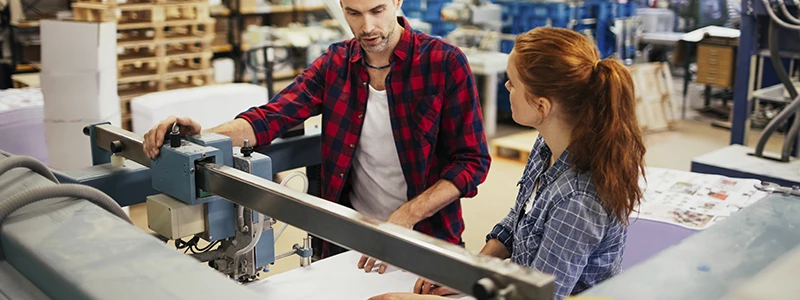How to become a Digital Printer

Digital printers use machines and software to control the production of print-based media for commercial print manufacturing sites and instant print shops.
Personal requirements for a Digital Printer
- Enjoy technical activities
- Good eyesight (may be corrected) and normal colour vision
- Good hand-eye coordination
- Able to carry out detailed work
- Aptitude for mechanical work
- Aptitude for working with computers
- Able to work as part of a team
Education & Training for a Digital Printer
You can work as a digital printer without formal qualifications. You will probably get some informal training on the job. You can also become a digital printer through an apprenticeship or traineeship. Entry requirements may vary, but employers generally require Year 10.
Duties & Tasks of a Digital Printer
Digital printers:
- Perform manual and automatic set up of digital print machines
- Advise on products and services
- Receive and process electronic documents
- Develop basic design concepts
- Load paper into feeding mechanisms
- Manage and monitor the order and execution of files in a printer’s job queue
- Operate die-cutting machines
- Undertake vinyl application, laminating, finishing and mounting
- Perform general administration duties and maintenance (such as maintaining order and query logs, cleaning and repairing equipment, and changing supplies)
- Keep production records.
Tasks
- Loads paper into feeding mechanisms.
- May set up and operate paper and bookbinding guillotines.
- Produces and manages digital print images, and transferring and outputting images.
- Prepares plates, blankets and impression cylinders on small offset lithographic printing presses.
- Undertakes maintenance, adjustments, repair and cleaning of machines.
- Monitors machine operations and quality of printing.
Employment Opportunities for a Digital Printer
Digital printers are employed by large and small commercial printing firms and shops. Technological development has been rapid in the printing industry with the widespread application of computerised systems. Demand is greatest for people familiar with the new techniques and technology.

Average age
51

Future Growth
N/A

Gender Share
20% female

Average full-time
39 hours

Weekly Pay
N/A

Skill level rating
Medium skill

Unemployment
Lower unemployment

Full-Time Share
78%

Employment Size
270

Employment by state
ACT: 1.1%
NSW: 33.0%
NT: 0.0%
QLD: 13.2%
SA: 3.6%
TAS: 2.5%
VIC: 35.7%
WA: 11.0%
Age brackets
15-19: 0%
20-24: 2.5%
25-34: 14.9%
35-44: 25%
45-54: 32.3%
55-59: 12.1%
60-64: 9.6%
65 and Over: 3.7%
Education level
Advanced Diploma/Diploma: 8.9%
Bachelor degree: 10%
Certificate III/IV: 47.6%
Post Graduate/Graduate Diploma or Graduate Certificate: 0.9%
Year 10 and below: 11.5%
Year 11: 5.4%
Year 12: 15.8%
Is the information on this page correct? Request update
Request Information Update
Related careers

